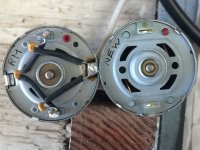My AP is fixed and wet tested for a few hours so I will be there for RTR. During the test, I saw this UL looking good and screaming out of the RedRock. Some magnification showed it to be Dave on his Olson Sled. I finished the repair without adding any of the bridged wires on the terminals. I don't run comms that would be interfered. Good thing because my soldering and electrical skills are rudimentary.
I found it beneficial to keep ram sections loose for dry testing on boat. For example, if you hear the motor turning and seizing, then 4 pins on the jack screw probably didn't engage the planetary gears correctly. I found it best to place planetary gears on the pins, then insert into pinion gear housing.
Also important when reassembling at bench, seat the motor into the black aluminum casing so that the black screw at the top of the motor fits into one of the two available recesses inside the black plastic coupler. This functions to keep the motor from spinning inside the housing.
I have always wanted to see the guts of my ram and learn how these work. But if you don't have the time or inclination, Raymarine charges $200-$260 and $600 for brand new. BTW, they have ceased their online tech forum.
$5 dollar electric motor at
https://www.parts-express.com/mabuchi-type-motor-rs-555sh-12v-dc-motor-(9-15v)-57mm-x-36mm--125-566
Raymarine has the motor with the bridge wires for about $100, part number I believe is Q114.
Some help in removing gears for the motor.
https://jeanneau.proboards.com/thread/2127. I used some shims and red loctite on my pinion shaft to help retention. The RM shaft has some built in edges that help with this.
I think it's important to take the Ram apart after a few seasons to lubricate the internals and inspect the insides. Water and salt does get inside (cover anyone one?!). Despite what some think, it's OK to manually push down the piston into the RAM housing as this is part of the test procedure. If it moves stiffly or not at all, time to service. The link below has schematics and test procedures at the back to help in repair of ST4000 RAM. Also has wheel pilot stuff, too. I could not find the legacy documents on RM's site.
https://jgtech.com/pdf/S1 Tiller and Wheel Service.pdf

